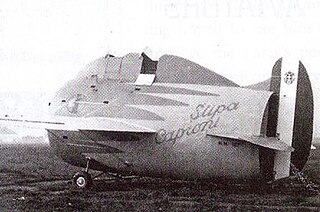
The Caproni Ca.165 was an Italian biplane fighter developed just before World War II, but produced only as a prototype, as the competing Fiat CR.42 Falco was selected for series production.

The Caproni Ca.97 was a civil utility aircraft produced in Italy in the late 1920s and early 1930s. As originally designed, it was a high-wing braced trimotor monoplane of conventional configuration with one engine mounted on the nose and the other two carried on strut-mounted nacelles at the fuselage sides. Examples were also produced with only the nose engine or only the two nacelle-mounted engines.

The Stipa-Caproni, also known as the Caproni Stipa, was an experimental Italian aircraft designed in 1932 by Luigi Stipa (1900–1992) and built by Caproni. It featured a hollow, barrel-shaped fuselage with the engine and propeller completely enclosed by the fuselage—in essence, the whole fuselage was a single ducted fan. Although the Regia Aeronautica was not interested in pursuing development of the Stipa-Caproni, its design influenced the development of jet propulsion.

The Caproni Ca.95 was a large, three engine, long range, heavy bomber prototype built in Italy in 1929. It could carry a 1,600 kg (3,500 lb) bomb load and had three defensive gun positions. Only one was built.
The Caproni Ca.131 was a prototype for a large aircraft built in Italy in 1934, intended for use as either a bomber or airliner. It was a conventional low-wing cantilever monoplane, powered by a radial engine on each wing and in the nose. The main undercarriage was housed within large streamlined spats. Configured as an airliner, it would have seated 17 passengers.

The Caproni Ca.16 was a single-engine monoplane designed and built by Caproni in the early 1910s.
The Caproni Ca.10 was a single-engine monoplane designed and built by Caproni in the early 1910s.

The Caproni Ca.9 was a single-engine monoplane designed and built by Caproni in the early 1910s.

The Caproni Ca.8 was a single-seat monoplane designed and built by Caproni in the early 1910s.

The Caproni Ca.22 was a single-engine monoplane made by the Italian company Aeronautica Caproni in 1913.

The Caproni Ca.11 was a single-engine monoplane designed and built by Caproni in the early 1910s.

The Caproni Ca.13 was a two-seater single-engine monoplane built by Caproni in the early 1910s.
The Caproni Ca.66 and Caproni Ca.67 were Italian night bomber aircraft designed to re-equip the post-World War I Regia Aeronautica.
The Caproni Ca.72 was an Italian night bomber designed to reequip the post-World War I Italian Air Force.
The Caproni Ca.79 was an Italian light bomber produced in the mid-1920s.
The Caproni Ca.103 was a biplane twin-engine bomber developed by the Italian company Aeronautica Caproni in the late 1920s.
The Caproni Ca.120 was a three-engine monoplane bomber built by Caproni in the 1930s.
The Caproni Ca.127 was a single-engine reconnaissance monoplane built by Caproni in the mid-1930s.
The Caproni Ca.142 was a three-engined multirole aircraft built by Caproni in the mid-1930s.

The Caproni Ca.53 was an Italian prototype light bomber built in the last months of World War I.











